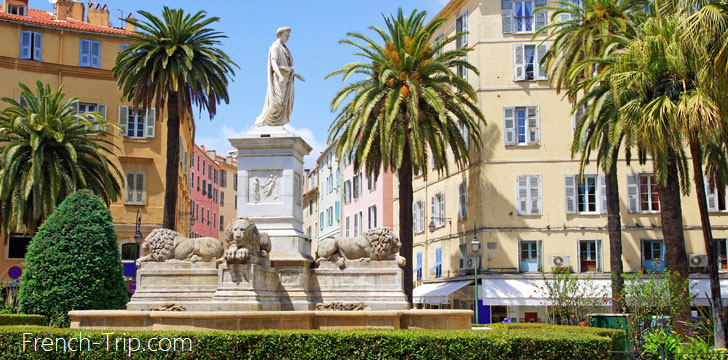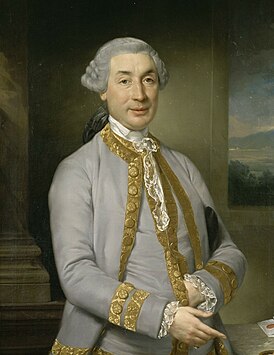Napoleon in Ajaccio

Napoleon Bonaparte, one of the most famous figures in European history, was born in Ajaccio on August 15, 1769, shortly after Corsica became part of France. His early years in the city shaped much of his identity, as the Bonaparte family was part of the Corsican nobility, and their home, the Maison Bonaparte, still stands today as a museum. This house, where Napoleon spent his childhood, contains personal artifacts and memorabilia that provide insight into his early life.
Ajaccio is filled with monuments and tributes to Napoleon, reflecting the city’s pride in its most famous son. Statues, such as the one in the Place Foch and the imposing equestrian statue in the Jardins de Casone, celebrate his legacy. The Fesch Museum, founded by his uncle, Cardinal Joseph Fesch, houses a renowned collection of Italian Renaissance art and is one of Ajaccio‘s cultural highlights.
Napoleon’s influence is felt throughout Ajaccio, not just in its landmarks, but also in the deep connection the city maintains with his memory. This makes the city a key destination for those interested in the life and legacy of the former emperor.

Napoleon in Ajaccio
Born in the family home on August 15, 1769, young Napoleon left for the College of Autun with his brother at the age of nine. In March 1779, he entered the military school of Brienne as a “royal pupil” and five years later, he was accepted into the École Militaire in Paris. On September 1, 1786, while on official leave, he left his regiment in Valence and spent a year in Ajaccio with his mother. During his next visit in 1787, he began working on a book about Corsica, a project that was dear to him.
In September 1789, Napoleon returned to Corsica, accompanying his brother Joseph to the Electoral Assembly tasked with electing Corsica’s first administration. He was also among those who welcomed Paoli, who had been pardoned by the Constituent Assembly after 20 years of exile. Napoleon returned to Valence in February 1791, but by the following autumn, he was back in Ajaccio, actively participating in local events until April 1792, serving as lieutenant colonel of a Corsican volunteer battalion.

On October 10, 1792, Napoleon set sail from Toulon with his sister Elisa, rejoining his battalion in Corte before heading on an expedition to the Maddalena Islands. Upon his arrival in Ajaccio, an assassination attempt was made on his life after Paoli was declared an outlaw on April 2, 1793. These events forced him to flee, and on June 11, 1793, he sailed to Toulon with his family.
After returning from the Egyptian campaign, Napoleon stayed in Ajaccio for a few days, from September 28 to October 6, 1799, residing in the renovated bedroom on the second floor, known as the “alcove.” His stay included a ball organized by Murat in the newly renovated gallery and a walk to Milelli accompanied by his general staff officers (Lannes, Murat, and Berthier). On October 5, he discreetly slipped out through a secret door in one of the bedrooms and rejoined the frigate La Muiron, anchored in Ajaccio.
Maison Bonaparte
La maison Bonaparte is the house where Napoleon Bonaparte was born. The house was owned by this family for almost all of this time, from 1682 to 1923.
The history of the house:
Napoleon was born in this house on August 15, 1769, and lived here until the age of nine before leaving for school in Autun. At the time, his parents, Carlo and Letizia Bonaparte, occupied the ground floor where the kitchen was located. In 1774, Napoleon’s father added a terrace to extend the house. Over time, the family acquired the second and third floors, which were originally owned by other relatives.

As supporters of the Republic, the Bonaparte family fled Corsica when the British occupied the island in 1793. Four years later, when Corsica returned to French control, Letizia Bonaparte came back to Ajaccio. She received compensation for losses suffered during the British occupation, which she used to renovate and enlarge the house. A gallery was added, and the rooms were furnished with items from Milan and Marseille. Napoleon’s last stay in the house was from September 28 to October 6, 1799, after his return from Egypt. In 1843, the house was inherited by Joseph Bonaparte and later passed to Napoleon III in 1852.
The room where Napoleon was born:

Napoleon Museum
Finally, in 1967, the house became a national museum, currently run by the National Museum of Malmaison and Bois-Pré. The building was expanded in 2004 with the purchase of the neighboring house, providing additional exhibition space dedicated to the Second Empire and temporary exhibitions.
The Revolution and the Napoleonic Family:
When the Revolution began, the Bonaparte family faced a challenging situation as they were strong supporters of republican ideals, in contrast to Paoli and Pozzo di Borgo, who had aligned themselves with the English. In May 1793, Letizia quickly fled Ajaccio with her children, relocating to Marseille. The family’s house and property were completely ransacked, and the English later requisitioned the home to store weapons, animal feed, and house procurement officers on the upper floor.
It wasn’t until late 1796, after the French expelled the British from Corsica, that Joseph Bonaparte was able to return to Ajaccio. Upon his arrival, he purchased an apartment on the second floor from Ignazio Pianelli and hired Samuel-Etienne Meuron, a Swiss architect and businessman who had designed the city’s fortifications, to help renovate the house. Under the law of January 31, 1797, victims of the English occupation were entitled to compensation, enabling the Bonapartes to restore their home. Letizia returned to oversee the renovation.
Letizia’s salon:

The house appears to have been completely renovated, with bricks, floor tiles and roofing tiles coming from Genoa and Marseille. In 1799, the work was completed, allowing Letizia, Fesch and young Louis to leave the island and rejoin their family in Paris. The house was left in the care of Camille Illary, Napoleon’s nanny.
Visiting Napoleon’s House
During the months of July, August and September, due to the high attendance, I strongly recommend arriving before 3:30 pm to be sure to enter the museum. The queue is very long during these months.
- Self-guided tour with audio guides
- People with reduced mobility do not have access to the entire museum. They can visit part of the first floor and the ground floor as well as the temporary exhibition.
- Opening Hours:
- Closed on Mondays
- October 1 – March 31: 10:30 AM to 12:30 PM and 1:00 PM to 4:30 PM
- April 1 – September 30: 10:00 AM to 12:30 PM and 1:15 PM to 5:30 PM
- July 1 – September 30: continuous opening 10 AM – 5:30 PM
- Last entry 30 minutes before closing.
- Ticket prices:
- Adult — €7
- Reduced — €5
- Free — 1st Sunday of the month
- Address: Rue Saint-Charles
- Getting there:
- Bus lines no. 1,2,3,4,5,7 Cathedral stop
- Bus and ferry station 200 m away
- Website
Carlo Buonaparte, Napoleon’s Father
 Carlo Buonaparte was a prominent public figure; he was a lawyer in the Corsican Executive Council, an expert in the royal jurisdiction of Ajaccio, and was granted the title of aristocrat by the King of France in 1771. He supported Corsica’s integration into the French state and in 1778 traveled to Versailles with Corsican deputies as a representative of the Corsican nobility.
Carlo Buonaparte was a prominent public figure; he was a lawyer in the Corsican Executive Council, an expert in the royal jurisdiction of Ajaccio, and was granted the title of aristocrat by the King of France in 1771. He supported Corsica’s integration into the French state and in 1778 traveled to Versailles with Corsican deputies as a representative of the Corsican nobility.
To emphasize his social standing, Carlo expanded and renovated the family home, adding a terrace and upgrading the interior. The walls of his bedroom were covered in crimson damask, and a marble fireplace was installed. The dining room was furnished with a large table seating 20 people.
When Carlo died prematurely in 1785 at the age of 38, his eldest son, Joseph, was only 17. It was their uncle, Archdeacon Luciano, who became the head of the family. He also expanded the house, acquiring a large neighboring building that included a kitchen, two bedrooms, a food store, and two lofts. Luciano also took over the family’s agricultural estate at Milelli, located about 3 kilometers from Ajaccio, which covered several hectares, part of which was used for vegetable gardening. However, the family faced financial difficulties, and Letizia had to economize to afford Joseph and Lucien’s school fees, while still providing for the education of her younger children (Jérôme was born in 1784).
After the death of their uncle, the long-awaited inheritance allowed the family to acquire new properties in Ajaccio and its surroundings.
Carlo Bonaparte had 11 children, with Napoleon being the fourth.
Monuments devoted to Napoleon in Ajaccio
Ajaccio is deeply connected to the legacy of Napoleon Bonaparte, and this is reflected in its numerous monuments, statues, and streets dedicated to him. Among the most notable is the grand bronze statue of Napoleon in Place d’Austerlitz, also known as the Grotte Napoleon. This imposing monument, surrounded by a rocky setting, features Napoleon in his imperial regalia atop a pyramid, and is a popular spot for visitors to reflect on his enduring influence.

Another significant statue is located in Place Foch, where Napoleon is depicted as a Roman emperor, standing proudly above a fountain with lions, symbolizing his authority and power. This square, with its palm trees and lively atmosphere, forms one of the city’s main gathering points.

The crowns decorating Ajaccio’s streets are modeled after the emblematic French imperial crown, which features a circular design with an ornate, jeweled appearance. They are prominently displayed on the central street of Ajaccio, known as Cours Napoléon, and various other locations around the city.
These crowns symbolize Napoleon’s enduring legacy and his deep connection to Ajaccio, where he was born and spent his early years. They not only honor his imperial status but also celebrate his contributions to French history. The use of these crowns in street decoration emphasizes Ajaccio’s pride in its historical association with Napoleon and its role as a significant site in his life.
→ Back to Ajaccio travel guide
Archives
Calendar
| M | T | W | T | F | S | S |
|---|---|---|---|---|---|---|
| 1 | 2 | 3 | 4 | 5 | 6 | 7 |
| 8 | 9 | 10 | 11 | 12 | 13 | 14 |
| 15 | 16 | 17 | 18 | 19 | 20 | 21 |
| 22 | 23 | 24 | 25 | 26 | 27 | 28 |
| 29 | 30 | 31 | ||||